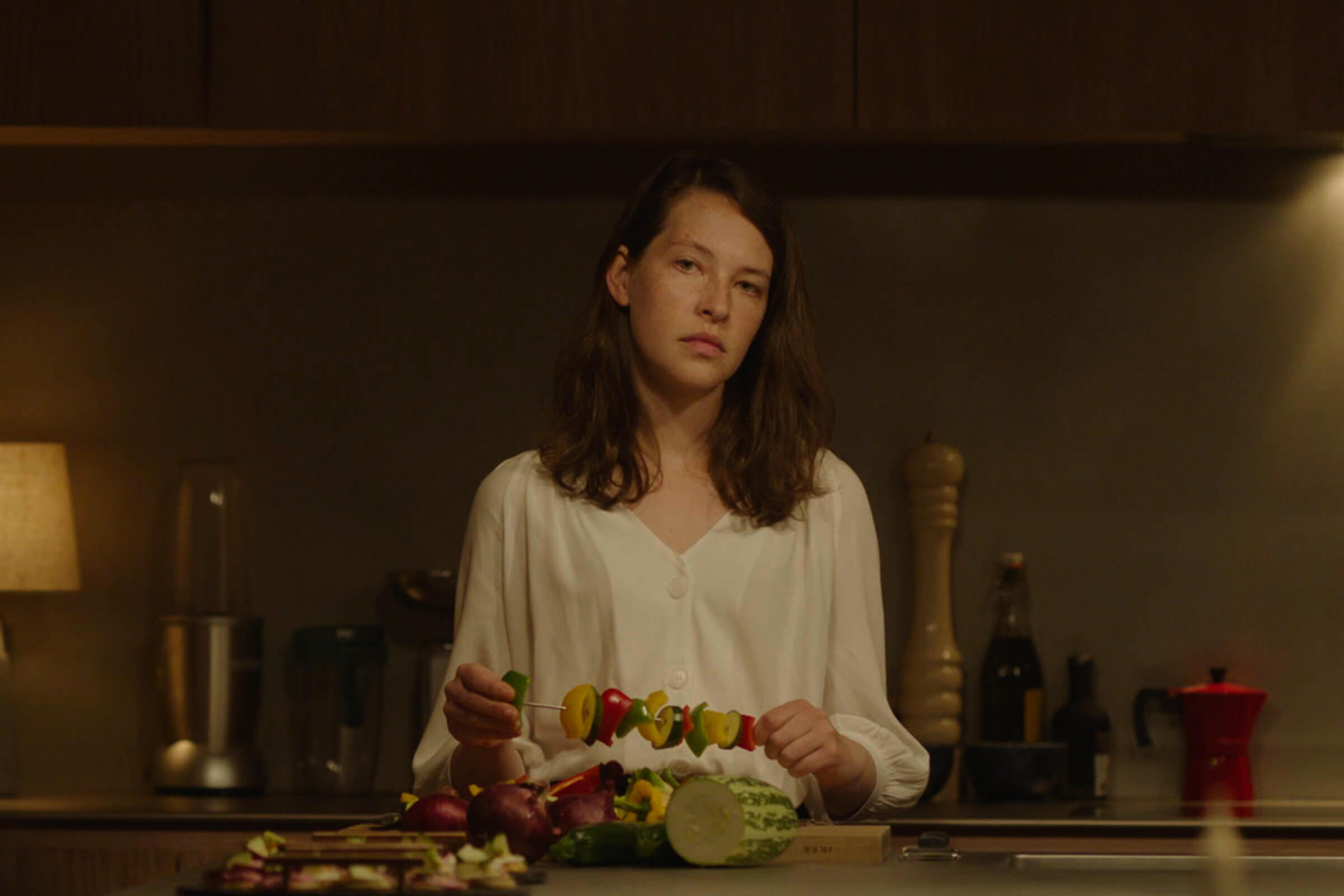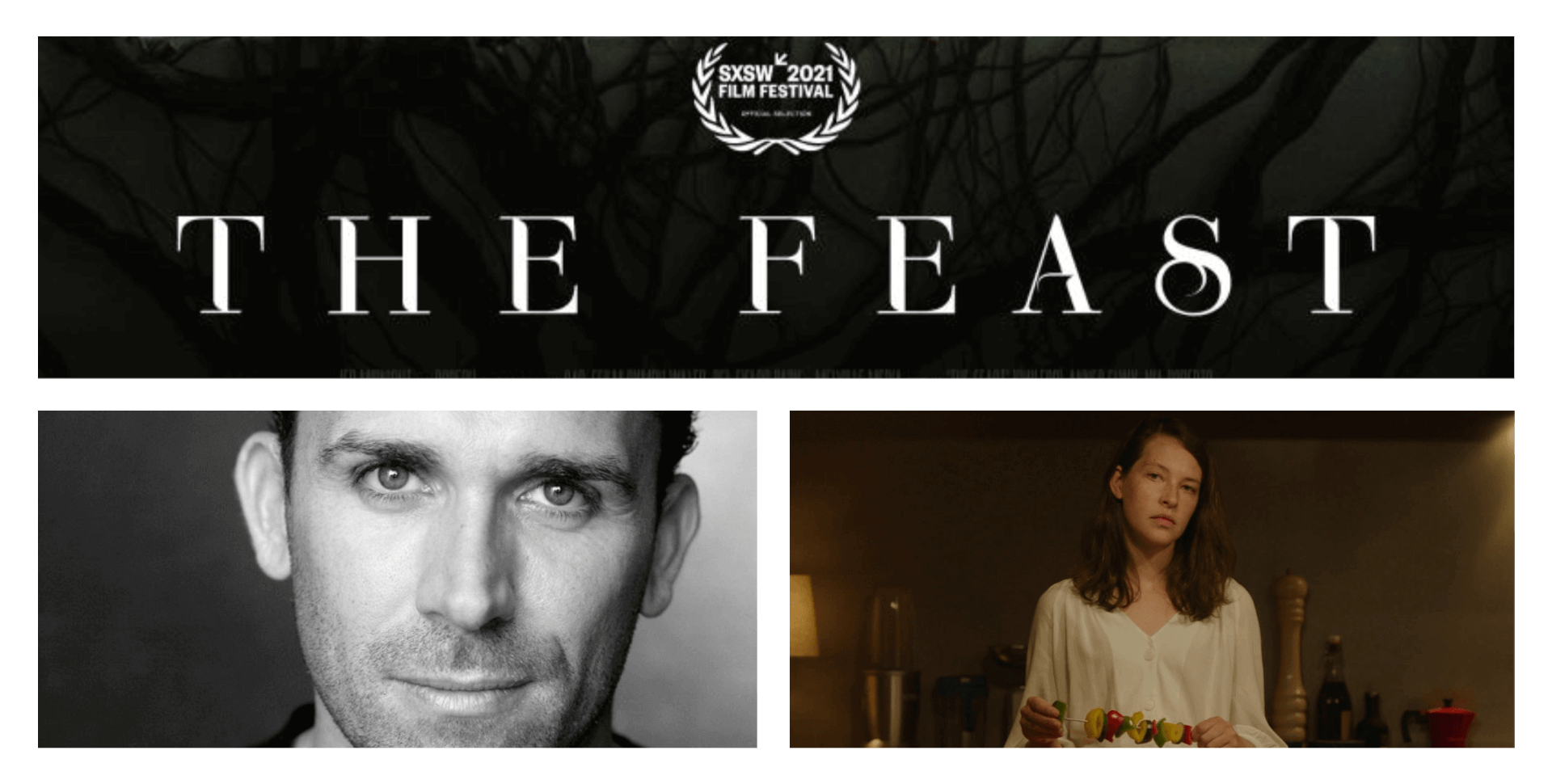The Feast is a 2021 horror | mystery | drama Welsh language film that takes place in a remote house in rural Wales — a young woman named Cadi (Annes Elwy) is hired to serve privileged guests at a dinner party for an unforgettable night.
Borrowing Tape had the opportunity to interview the filmmaker of The Feast, Lee Haven Jones. The film is available on VOD, Digital HD, and cinemas on November 19, 2021.
How did you approach the directorial process for The Feast?
I have always dreamt about making a film and so my directorial approach felt almost subconscious — as if it had been in my muscle memory for a long time. I always start with the script and was fortunate enough to collaborate closely with Roger (the writer). Unlike many directors whose work explicitly references other films as a matter of course, I try to deny influence as much as possible. When I embark on a project I don’t think, ‘Oh, this should be like…’; rather, I attempt to clear my mind and create the circumstances in which ideas can percolate, form, evolve, and crystalize. I am a bit of a ‘magpie’ in that I ‘find’ inspiration far and wide, in various forms and from a vast array of fields: I love architecture, photography, visual and performance art; I have a background in theatre which tends to inform my vision substantially. I guess my process is best described as being inter-disciplinary.
What was it like working with Writer Roger Williams?
Roger and I are close friends and have worked together a number of times — it is a creative partnership that has been forged over several years. We had worked on a few television projects together, but The Feast was our first foray into film and so in many ways, it was an education for us both. We are big film fans and the process involved sharing our cinematic influences and challenging and provoking each another to get the best out of the project. It is a very easy relationship rooted in trust and respect.
What was the casting process like for The Feast?
Casting The Feast was remarkably straightforward. Roger and I often conceive of projects with actors already in mind and so we circumvented the traditional casting process. I had a very clear idea of who I wanted in the film; the key challenge with this piece from a casting perspective was persuading the actors to embrace the strangeness of my vision for the film. After all, it’s a film that begins in a naturalistic vein before taking an expressionistic turn and finishing in a blaze of theatricality. And the actors, to their credit, committed without reservation.
The Feast is a beautifully shot film. What was it like working with Cinematographer Bjørn Ståle Bratberg on the film's aesthetic?
Bjørn and I have been working together for several years and so there’s a shared language and body of experience, as well as a really useful shorthand. We always set ourselves specific formal challenges at the beginning of a project that furnish the work with the precision and rigor that we both enjoy. Bjørn is very intuitive and can often read my intentions before I articulate them. That’s the benefit of having a kindred creative spirit on set. It’s alchemy in many ways!
Could you also tell us about the decisions behind the Production Design and Art Direction in The Feast?
I found the magnificent location for the film very early on in pre-production and the location itself informed a number of the design and art direction decisions we made. The house is a metaphor for the strained family dynamic that exists between the individual members and so the aesthetic within the house is spartan and austere. It is a cold, minimal environment that stands in stark contrast to the wild, lush landscape in which it sits. There is a desaturated look to the film at first reflecting the repressed culture at work within this family, punctuated with pops of green, representing nature, and subtle reds, foreshadowing the horror that ensues. And as the film unfolds and we are led deeper into the dark heart of this dysfunctional family, the images become bolder, the compositions more robust and the color contrast more intense.

There are some pretty unexpected gory/violent moments in the film. How did you handle this particular element of the filmmaking process — in terms of subverting viewer expectations and filming violence/gore?
There are a few moments of subtle gore, but primarily the film operates on the power of suggestion and works at the level of implicit psychological terror rather than explicit physical violence. Like the work of Hitchcock, much of the violence in the film is imagined or is in the audience’s imagination. Terror manifests itself through pace — the film is a slow burn that is big on mood and atmosphere, and relies on suppressed and sustained action to deliver a tone that is loaded with unease; accompanied by sporadic explosions of horror that punctuate the film at specific moments and provide the pay-off that an audience might expect of a genre film. I have endeavored to craft a tangible sense of creeping dread in the film, a relentless slow-burn of intrigue and suspense — we can see the danger, but cannot prevent its inexorable pull — and I hope that the audience, much like the family at the heart of the piece, is slowly but surely enveloped in Cadi’s hypnotic spell.
Can you tell us about working on the score with Composer Samuel Sim?
Like many of the other collaborators on the film, Sam is a trusted creative ally. For this project, Sam and I decided that we should depart from the kind of work we have generated previously and create something more experimental — a soundscape in many ways, in which instruments are used in unusual ways and sounds synthesized and mutilated. His approach reminded me of Shakespeare’s line in The Tempest – "This isle is full of noises." There is very little music at first; but as the characters are challenged by Cadi, their worlds become tormented with sounds. Score and soundscape are so important to the overall tone and feel of the film. It’s a not pretty score but is highly charged and affective.
The Feast slowly builds up the tempo into the shocking events of the ending. Could you describe the collaborative process of working with Editor Kevin Jones?
This was the first time I had worked with Kevin, but we exchanged a number of film references before embarking on the project and worked hard at ‘re-tuning’ our storytelling senses. Like myself, Kevin has worked mainly in television which is more of a literal medium. But through a process of trial and error, we discovered a more cinematic mode of articulation that prioritized ambiguity and allowed the story to breathe. Rather than spoon-feeding the viewer, our focus was on drawing the audience in. It was a very clear direction that form should mirror content — and so as the family implodes, the structure of the piece fractures, and images begin to elide. The hallucinogenic, dream-like quality of the denouement is a visceral spectacle to behold thanks to Kev’s hard work!
Wow, what a disturbing ending — perverse and mysterious. Could you clarify Cadi's motivation for her actions? How much of what happened was due to the family choosing to farm on the Rise?
Cadi is motivated by revenge for the devastation that the family is proposing to inflict on the Rise by allowing the mining company to drill for precious minerals. And in the final shot of the film — when Cadi breaks the fourth wall and looks deep into the lens (and by extension the soul of the audience) — we witness the existential impact and true cost of Cadi’s suffering at the hands of the family.
What are your favorite scenes from The Feast — from on the set and in the final cut?
For impact and economy of expression, I love the opening sequence of the film when we discover the family and learn about their specific characteristics. It’s an elegant, ambiguous, and intriguing sequence laced with humor that sets out the stall of the film very clearly — and is interrupted abruptly by the foreshadowing strike of an ax. As for a scene that I enjoyed filming, there was a particular joy in seeing Euros feasting like a pig. There’s a satisfyingly visceral feel to the scene that required Rhodri’s full commitment. He went there!
Where did the principal photography take place, and how long was production?
Principal photography took place in Llanbister in Powys, Wales in June/July 2019 and the shoot was 18 days long.
Which films/directors have influenced you as a filmmaker, including The Feast?
Michael Haneke
Jonathan Glazer
Lynne Ramsay
Julia Ducournau
Yorgos Lanthimos
What are some of your favorite movies from the past decade?
Ida
Under The Skin
Tyrannosaur
Moonlight
You Were Never Really Here
Raw
Which themes and subject matters interest you as a filmmaker?
The importance of being true to yourself and your people and the consequences of greed and avarice.

